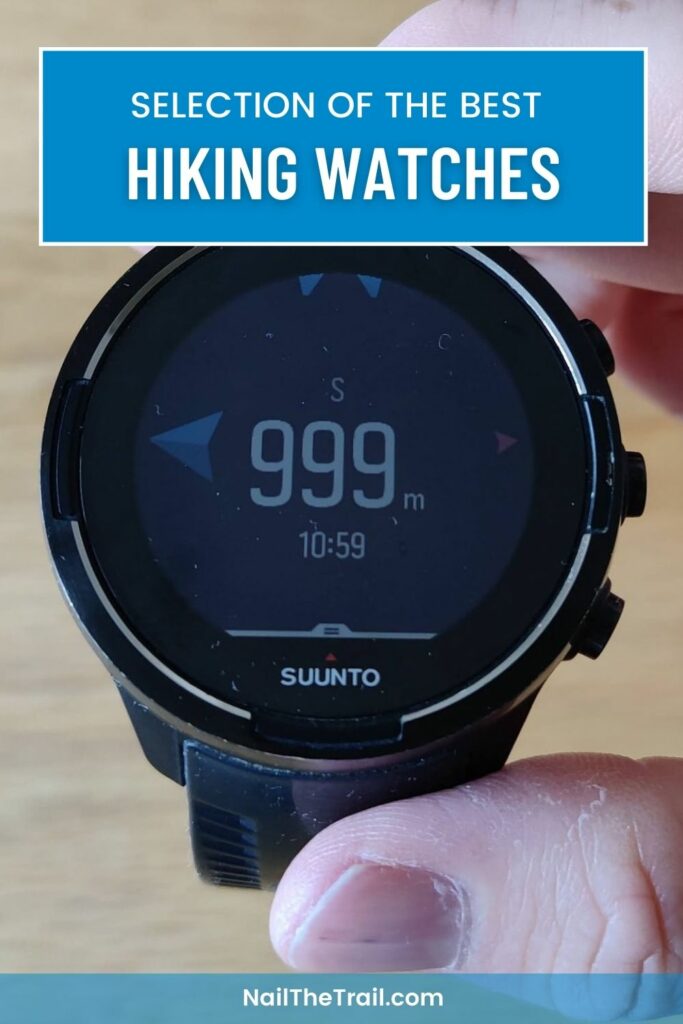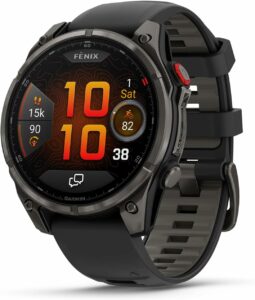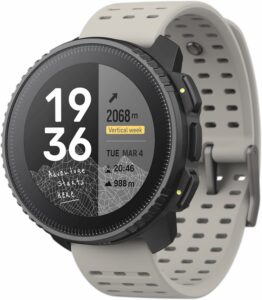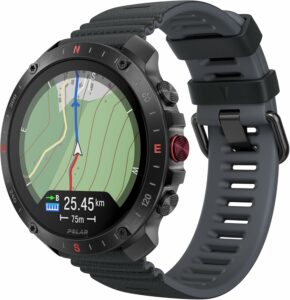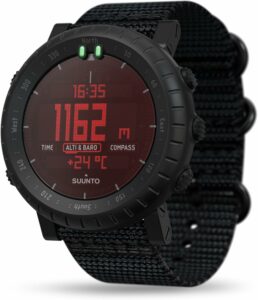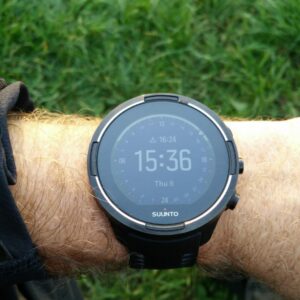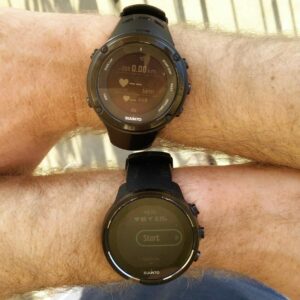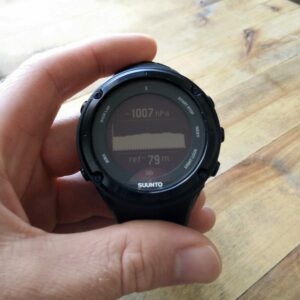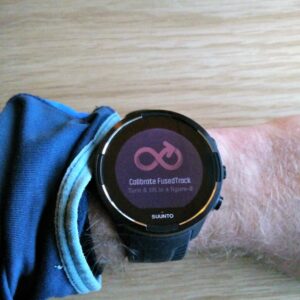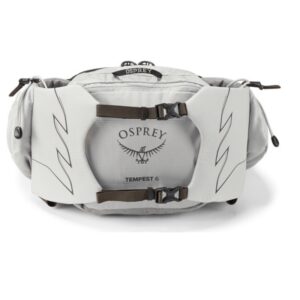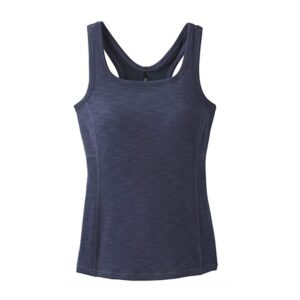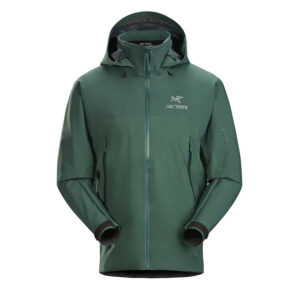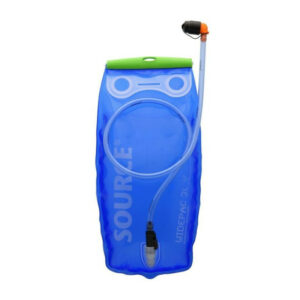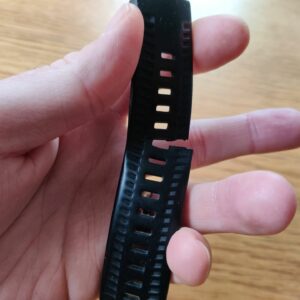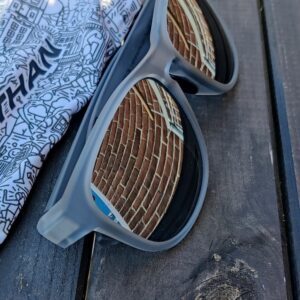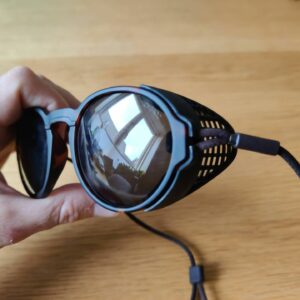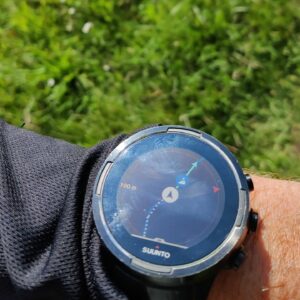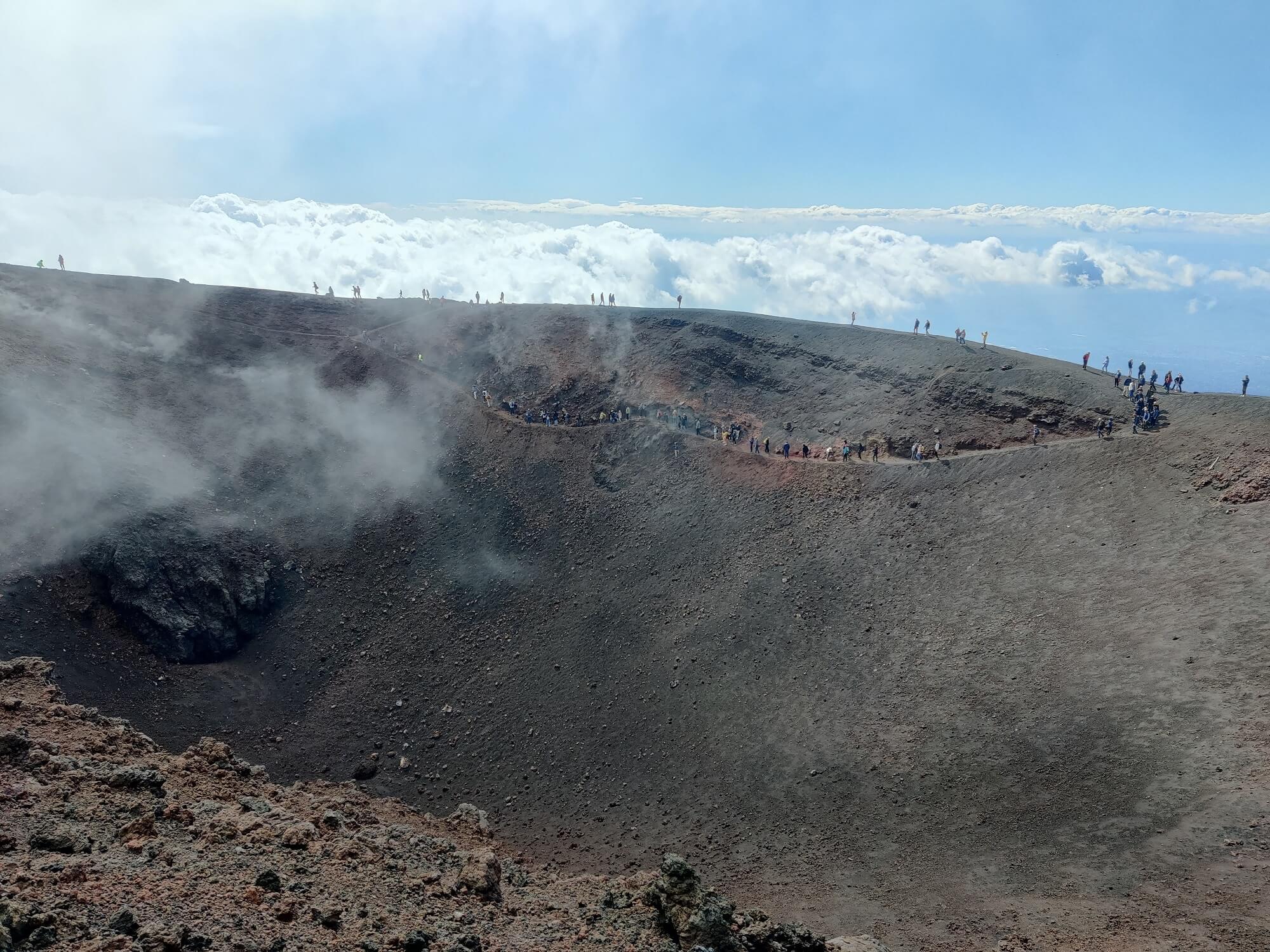A good hiking watch doesn’t just show time and date. It also provides altitude, location, air‑pressure trends, navigation assistance and sunrise/sunset times. Theis information helps with planning, route finding and predicting the weather. GPS‑enabled watches have become extremely popular in recent years, but non‑GPS watches still appeal to some users because of their simple interface and extremely long battery life. Here we reviewed the best hiking watches ranging from full‑featured smartwatches to minimalist ABC (altimeter-barometer‑compass) models.
While GPS certainly has its advantages, some do prefer a watch without GPS because because of longer battery life, less complicated user interface, and lower price. Nevertheless, we’re big fans of GPS watches because they’re so useful for navigation along the trails. All the watches in this selection are equipped with a compass, altimeter and barometer – features that we consider essential for activities such as hiking, trekking, mountaineering, and backpacking. Since new models of hiking watches are regularly released, we continuously update this selection to always recommend you the best products available. Nevertheless, below, you’ll find some tried-and-true classics that haven’t been beaten in terms of functionality – yet.
Updated Content
We regularly update our reviews and selections to always recommend you the best products on the market.
Expert Selections
We only list top-tier products. Read how our selections of best hiking products differ from others here.
Links
We use affiliate links and may receive a small commission on purchases at no extra cost to you.
1. Our Hiking Watches Picks
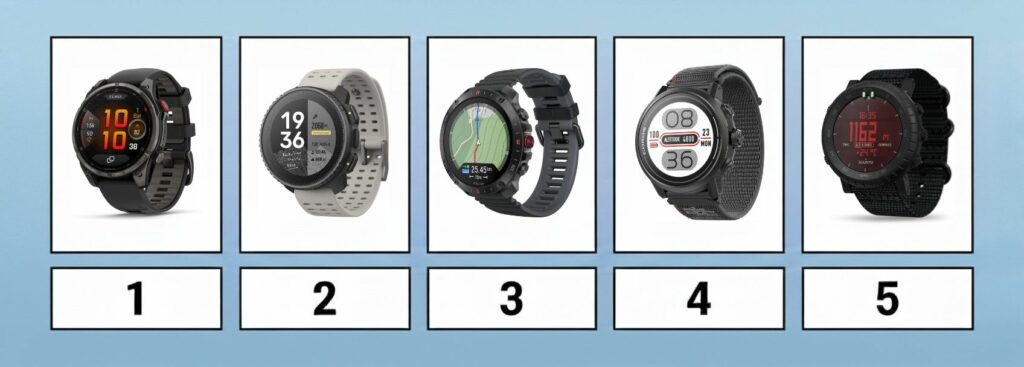
Best Hiking Watches
2. Comparison of Hiking Watches
| Feature/Product | Garmin Fenix 8X PRO | Suunto Vertical Titanium Solar | Polar Grit X2 PRO | Coros Apex 2 | Suunto Core Alpha |
|---|---|---|---|---|---|
| Weight | 3.17 oz. | 2.61 oz. | 2.78 oz. | 1.9 oz. | 2.36 oz. |
| Weight (Metric) | 90 g | 74 g | 79 g | 53 g with silicone band | 67 g |
| Case Size | 2.0 x 2.0 x 0.6 in. | 1.9 x 1.9 x 0.5 in. | 1.9 x 1.9 x 0.5 in. | 1.7 x 1.7 x 0.5 in. | 1.9 x 1.9 x 0.5 in. |
| Case Size (Metric) | 5.1 x 5.1 x 1.6 cm | 4.9 x 4.9 x 1.4 cm | 4.9 x 4.9 x 1.3 cm | 4.3 x 4.3 x 1.3 cm | 4.9 x 4.9 x 1.5 cm |
| GPS | Yes + GLONASS & Galileo & BeiDou | Yes + GLONASS & Galileo & BeiDou & QZSS | Yes + GLONASS & Galileo & BeiDou & QZSS | Yes + QZSS, GLONASS, Galileo & BeiDou | No |
| Display Type | AMOLED or MicroLED | Color Touch Screen | AMOLED Color Touch Screen | Color Touch Screen | Matrix |
| Glass Material | Sapphire Glass | Sapphire Glass | Sapphire Glass | Sapphire Glass | Mineral Crystal |
| Strap Material | Silicone | Silicone | Silicone | Silicone or Nylon | Silicone |
| Water Resistance | 100 m | 100 m | 100 m | 100 m | 30 m |
| Battery | Rechargeable lithium-ion | Rechargeable lithium-ion | Rechargeable lithium-ion | Rechargeable lithium-ion | CR2032 |
| Battery Life | Up to 27 days in smartwatch time mode | Up to 60 days in smartwatch time mode | Up to 10 days in smartwatch time mode | Up to 13 days in smartwatch time mode | 12 months with normal use |
| Altimeter | Yes (GPS and Barometric) | Yes (GPS and Barometric) | Yes (GPS and Barometric) | Yes (GPS and Barometric) | Yes (Barometric) |
| Barometer | Yes | Yes | Yes | Yes | Yes |
| Thermometer | Yes | Yes | Yes | Yes | Yes |
| Compass | Yes | Yes | Yes | Yes | Yes |
| Sunrise and Sunset Times | Yes | Yes | Yes | Yes | Yes |
| Storm Alarm | Yes | Yes | No | Yes | Yes |
| Bluetooth | Yes | Yes | Yes | Yes | No |
| Smartphone Notifications | Yes | Yes | Yes | Yes | No |
| Vibration Alerts | Yes | Yes | Yes | Yes | No |
| Heart Rate Belt Support | Yes | Yes | Yes | Yes | No |
| Wrist Heart Rate | Yes | Yes | Yes | Yes | No |
| GPS Navigation | Yes | Yes | Yes | Yes | No |
| GPS Tracking | Yes | Yes | Yes | Yes | No |
| Track Back | Yes | Yes | Yes | Yes | No |
| Planning Software | Garmin Connect | Suunto App | Polar Flow | Coros App | None |
| Mobile App | Yes (Garmin Connect) | Yes (Suunto App) | Yes (Polar Flow) | Yes (Coros App) | None |
3. The Selection
Garmin Fenix 8 Pro
Flagship GPS watch with LTE and satellite messaging
Suitable for:
- Hiking
- Mountaineering
- Trekking
- Climbing
- Cycling
- Swimming
- Running
- Backpacking
- Everyday use
The Garmin Fenix 8 replaced the highly popular Garmin Fenix 7 as the brand’s flagship outdoor smartwatch. The latest model of the Fenix 8 series is the 8 PRO watch which features LTE and two‑way satellite messaging (inReach subscription is required). That means that you can exchange two-way text and voice messages directly from your wrist by using the smartwatch’s built-in speaker and microphone. Due to inReach satellite technology this is possible also where there no cell phone reception. The watch comes in two versions; AMOLED and micro-LED. The micro-LED version is much more expensive and features a superior display with amazing brightness and clear view at any angle. The micro-LED is only available in 51mm case size while the AMOLED is available in both 51mm and 47mm case size. The battery life varies by model: the 47 mm AMOLED model offers 15 days in smartwatch mode and 44 h of full‑GPS use, while the larger 51 mm AMOLED model lasts 27 days in smartwatch mode and 78 h of GPS tracking. The micro‑LED version trades battery life (approximately 10 days smartwatch and 44 h GPS) for a better display.
We are very satisfied with Garmin’s refined interface and class‑leading mapping and training features. TopoActive maps come pre‑loaded and you can download additional region‑specific maps; there are also ski‑resort maps, golf maps and advanced navigation tools. The new Fenix provides multi‑band GNSS, a three‑axis compass, altimeter, barometer and thermometer, plus sensors for heart rate, pulse oximetry and body‑battery energy. Bluetooth music and Garmin Pay remain on board. Downsides include the high price—especially for the micro‑LED version—and the fact that early testers report occasional software bugs. We recommend the Fenix 8 Pro for adventurers who want the most versatile watch available and are willing to pay for cutting‑edge tech.
Pros:
- LTE and satellite messaging enable off‑grid two‑way communication
- Bright micro‑LED/AMOLED display options
- Pre‑loaded topo maps and advanced navigation
- Extensive training and health metrics
- Choice of 47 mm or 51 mm case sizes
Cons:
- Very expensive, especially the Micro‑LED variant
- Shorter battery life in the brightest display option
- Slightly heavier than the old Fenix 7 series
Video

Suunto Vertical Titanium Solar
GPS watch with unmatched battery life
Suitable for:
- Hiking
- Mountaineering
- Trekking
- Climbing
- Cycling
- Swimming
- Running
- Backpacking
- Everyday use
The Suunto Vertical Solar stands out for its incredible battery life. Equipped with solar charging, the watch provides 85 hours of continuous GPS recording and up to 500 hours of GPS recording in battery‑saving tour mode. In everyday smartwatch use it can run for up to one year on a single charge, but this depends on sufficient solar exposure and is for standby use only. The watch also offers free offline maps which show contour lines and trails but lack place names and turn‑by‑turn instructions . Nevertheless, this might change in the future with an update.
The Vertical’s 49 mm case uses a titanium bezel and sapphire glass for display. Sapphire glass is scratch-resistant. Despite its large size it looks sleek enough for daily wear. Suunto uses a dual‑band GNSS chipset for improved accuracy and a faster satellite fix. Activity tracking covers over 90 sports and the watch is water‑resistant to 100 meters. The Suunto Vertical Titanium Solar is perfect for hikers who prioritize long battery life, durability and accurate tracking. If you find this watch too expensive do check out the sibling Steel Solar and Steel models. The Suunto Vertical Steel is a bit heavier and doesn’t have solar charging while the Steel Solar model is just a bit heavier but equipped with solar charging just like the Titanium model.
Pros:
- Exceptional battery life—up to one year in daily mode
- Dual‑band GNSS and accurate tracking
- Free global offline maps
- Durable titanium and sapphire construction
- Solar charging extends battery life
Cons:
- Only one relatively large case available (49 mm)
- Fewer customizable sport modes than Garmin
Video

Polar Grit X2 Pro
GPS watch with AMOLED display and advanced sensors
Suitable for:
- Hiking
- Mountaineering
- Trekking
- Climbing
- Running
- Everyday use
- Backpacking
The Polar Grit X2 Pro replaced the popular Polar Grit X in 2024 and offers all features typically found in top‑tier expedition watches. It has a bright 1.39‑inch AMOLED display protected by sapphire glass and housed in a 48.6 mm case that meets MIL‑STD‑810H durability standards. Polar redesigned the antenna and added dual‑frequency GNSS so the watch can lock onto satellites quickly and maintain accuracy even in sense forests and canyons. Battery life is impressive: about 10 days in everyday use and 43 hours of continuous GPS tracking, with a 140‑hour eco mode for multi‑day treks.
Navigation is one of the Grit X2 Pro’s standout features. The watch includes 32 GB of onboard storage for offline topographic maps and supports Strava route syncing; you can follow turn‑by‑turn directions on the crisp display and measure vertical speed during steep climbs. Polar also incorporated an ECG sensor, heart‑rate variability tracking, a skin‑temperature sensor and advanced recovery tools that rival those of Garmin and Coros. The watch is water‑resistant to 100 m and supports over 150 sport profiles. On the downside, testers note that it’s heavy (79 g in steel) and extremely expensive and still lacks extras like onboard music and contactless payments. The Polar Grit X watch is available in three different versions: Grit X2, Grit X2 Pro and Grit X2 Pro Titan. The Grit X Pro is a bit bigger than the Grit X model. Due to bigger size it’s also equipped with a bigger battery which has a longer lifetime. The Titan model has all features of the PRO model but is made of even sturdier and lighter materials.
Pros:
- Bright, high‑resolution AMOLED display with sapphire glass
- Dual‑frequency GNSS and redesigned antenna for superior tracking
- Offline topo maps and 32 GB storage; Strava route syncing and vertical speed metrics
- Advanced health sensors (ECG, HRV, skin temperature) and 100‑m water resistance
- Respectable battery life for an AMOLED watch (around 10 days regular use; 43 h GPS; 140 h eco mode)
Cons:
- Heavy and very expensive
- No onboard music or contactless payments
- App interface is less polished than Garmin’s or Coros’
Video

Coros Apex 2
Compact GPS watch with altimeter, barometer and compass at a fair price
Suitable for:
- Hiking
- Mountaineering
- Trekking
- Cycling
- Climbing
- Swimming
- Running
- Backpacking
- Everyday use
Coros has gained a loyal following by offering high‑performance watches at reasonable prices. The Apex 2 embodies this ethos. It uses a titanium alloy bezel, sapphire‑glass display and a simple dial‑and‑button interface that’s easy to operate with gloves. The watch measures 42 mm across and has 29 sport modes. ABC sensors, sleep tracking, sport tracking and navigation maps are all built in, and recent software updates have added turn‑by‑turn navigation, HRV monitoring and Find My Phone/Watch tools.
Battery life is another highlight. In tests, the Apex 2 lasted around 44 hours of full‑GPS recording, and Coros claims 40 hours in standard GPS mode and up to 13 days in time mode. Charging is quick: from empty to full takes about 98 minutes. The main trade‑offs are the small screen, the loop band that some dislike and a companion app that isn’t as polished as Garmin’s or Suunto’s apps. Nevertheless, the Apex 2 is a powerful watch for a very reasonable price.
Pros:
- Durable titanium and sapphire construction
- ABC sensors (altimeter, barometer and compass)
- Turn‑by‑turn navigation and offline maps; 29 sport modes
- Excellent battery life (around 44 h GPS; fast charging)
- Great value for the features provided
Cons:
- Small 42 mm screen can feel cramped for detailed maps
- Band style may not appeal to everyone
- App ecosystem is less mature than Garmin’s
Suunto Core Alpha
Rugged ABC watch with year‑long battery life
Suitable for:
- Hiking
- Mountaineering
- Trekking
- Backpacking
- Everyday use
While GPS smartwatches dominate the market, there’s still a place for simple, reliable ABC watches. The Suunto Core Alpha is a modern take on a classic altimeter watch. A red, night‑vision‑friendly backlight sets it apart from the standard Suunto Core. The Core Alpha features a barometric altimeter, barometer, compass, temperature, storm alarm and sunrise/sunset times. It is tested to MIL‑STD‑810 standards and is made in Finland. Unlike GPS watches that need frequent charging, the Core Alpha uses a user‑replaceable CR2032 battery that lasts around 12 months.
The watch measures 49.5 × 49.5 × 15.1 mm and weighs 67 g. It’s water‑resistant to 30 m and even includes a depth meter for snorkeling to 10 m. Long‑term reviews highlight its ruggedness, and the storm alarm and sunrise/sunset display prove especially helpful for mountaineering. If you prefer a watch that you can wear for a year without charging and don’t need GPS, the Suunto Core Alpha is the best option.
Pros:
- Altimeter, barometer and compass with storm alarm and sunrise/sunset times
- Military‑tested durability; made in Finland
- Red night‑vision‑compatible backlight
- User‑replaceable battery lasts around 12 months
- Affordable compared to GPS watches
Cons:
- No GPS or mapping
- Large case and limited smart features
- Strap can be noisy
5. Hiking Watch Buying Advice – What is important?
Hiking Features:
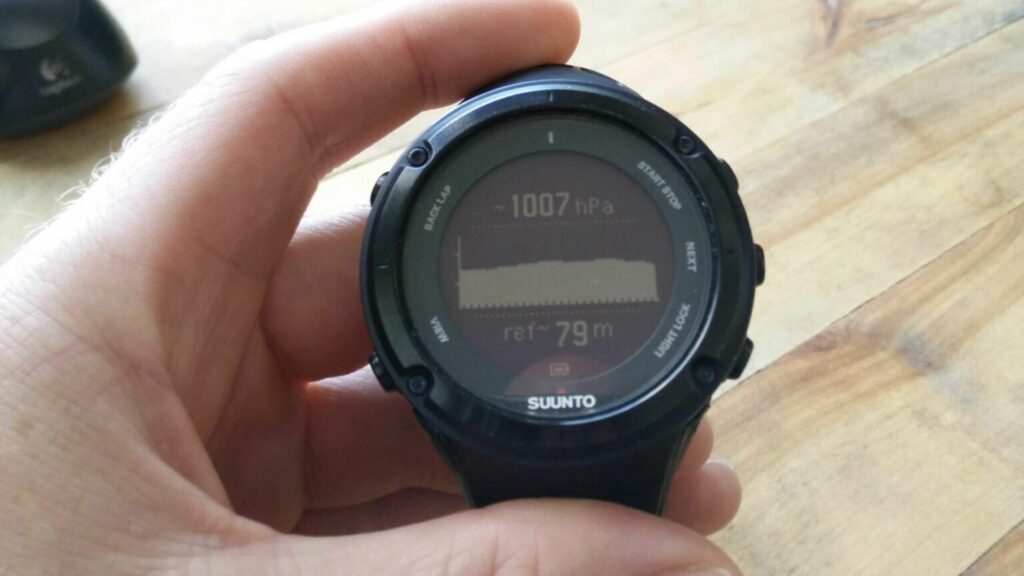
Hiking Features: Hiking watches are equipped with compass, altimeter and barometer
Every hiking watch should feature altimeter, barometer and compass functions. Watches with these features are often called ABC watches. So, why it’s so important that a hiking watch has these three features? Let’s explain.
Barometer
The barometer detects changes in the atmospheric pressure and thus allows you to easily predict the weather; if the atmospheric pressure is increasing, the weather will improve and reversely; if the atmospheric pressure is falling, the weather will worsen (clouds, rain etc.). A rapid drop in the atmospheric pressure normally indicates a storm rising. All watches listed in this review show the atmospheric pressure and its tendency graph (how the atmospheric pressure has changed in the last hours). Furthermore, they also all have a storm alarm feature which warns you if the atmospheric pressure drops significantly. This might save your life if you are on an exposed mountain side. Read more about barometer feature in watches in our article How to use barometer on a Suunto watch to predict the weather.
Altimeter
An altimeter shows you how high above sea level you are and is based on the barometric pressure or GPS data. A GPS altimeter is much more precise than a barometric altimeter and doesn’t require any calibration. The altimeter feature comes in handy for navigation – it is easier to find your location on a map if you know how high above the sea level you are.
Compass
A compass shows you the four cardinal directions (North, East, South and West) as well as bearing and is thus crucial for navigation. With the compass feature and a proper map, you can easily do triangulation to determine your current location.
Thermometer
Some hiking watches are also equipped with a thermometer which comes in handy on multiday trips. We often use thermometer on the watch to measure the temperature outside the tent to appropriately plan and layer our clothes before we set out on the trail again. However, it is important to note that the thermometer will normally measure temperature most accurately when the watch is not on your wrist as your body heat affects the measurements.
GPS:
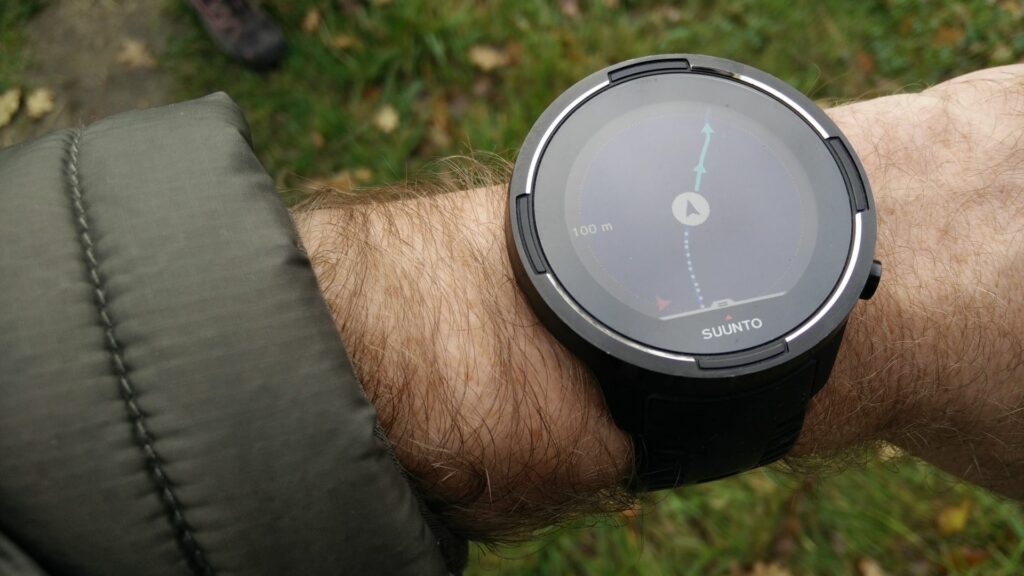
Hiking watches with GPS help you with the navigation
Most hiking watches support GPS which is currently the best solution for navigation and tracking. Some GPS watches also support alternative positioning systems like GLONASS, Galileo etc. A GPS watch allows you to instantly get the coordinates of your current location. Furthermore, it can also show current speed, distance, ascent, descent, and other GPS-based information. You can import routes in GPX or similar formats to most GPS watches. These routes can then be used for navigation as the watch shows your current location in relation to the GPX route.
GPS watches also track (record) your activities and allow you to export the details (duration, distance, average speed, total ascent, total descent and other parameters) to web or mobile apps such as Suunto App or Garmin Connect for analysis. However, GPS watches have a shorter battery life than watches without GPS. This downside is somewhat mitigated by GPS watches being equipped with rechargeable batteries. On off the grid backpacking trips, a solar charger enables you to recharge your GPS watch.
Durability and Weight
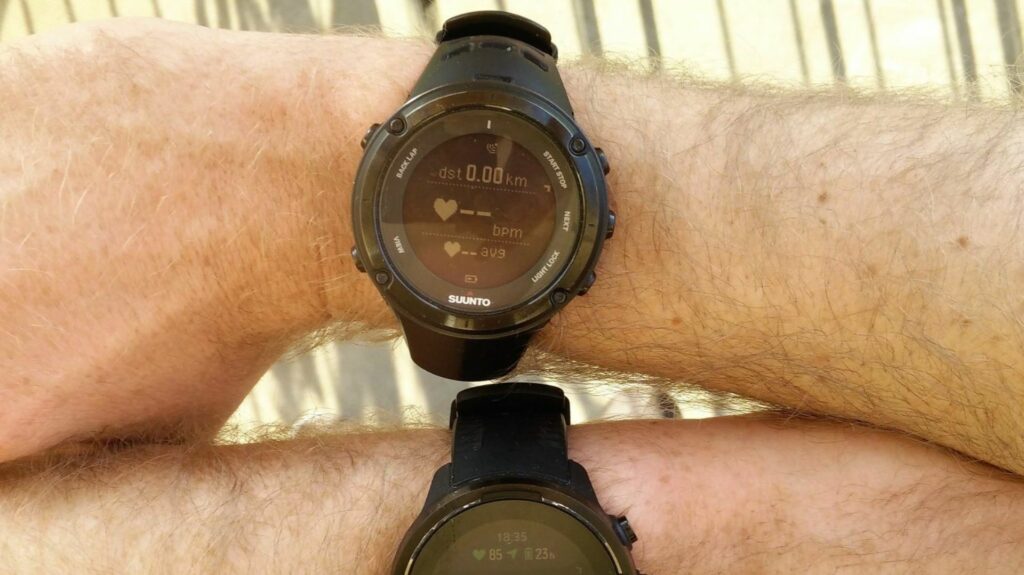
Durability and Weight: Watch for hiking must be robust and sturdy
A hiking watch must be sturdy and robust. However, the watch also shouldn’t be too heavy so you can wear it comfortably for longer periods. Therefore, hiking watches are typically made of fiber-reinforced polymers and sometimes feature a rear cover made of metal. The straps are typically made of silicone and less often from textile. Textile straps are harder to maintain because they must be washed regularly in order not to get smelly. Some watches come with Sapphire glass lenses for increased resistance against scratches. Sapphire glass provides superior scratch resistance in comparison to the more common mineral crystal. However, watches with Sapphire glass lenses are also significantly more expensive. Therefore, Sapphire glass is often an optional feature.
Heart Rate Monitor
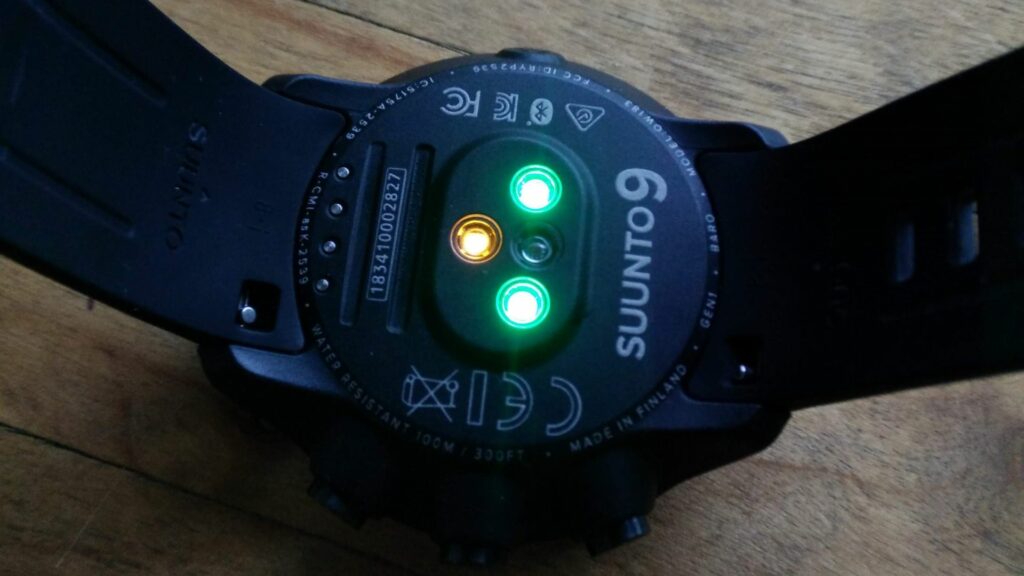
Heart Rate Monitor: New hiking watches are equipped with wrist heart rate monitors
Many hiking watches come with heart rate monitor functionality. Thereby, the watch can be connected to chest strap heart rate monitor which transfer heart rate data to the watch. Premium models of hiking watches have wrist heart rate monitors in addition to the option to connect a chest strap heart rate monitor. A wrist based heart rate monitor don’t require any extra device as they are part of the watch. They measure heart rate directly on your wrist by shining light into your blood vessels and detecting changes in blood volume. Wrist heart rate monitors are surprisingly accurate except for activities that involve a lot of pressure on hands (weightlifting, biking and such). Read more about the accuracy of wrist-based heart rate monitors here.
Connectivity
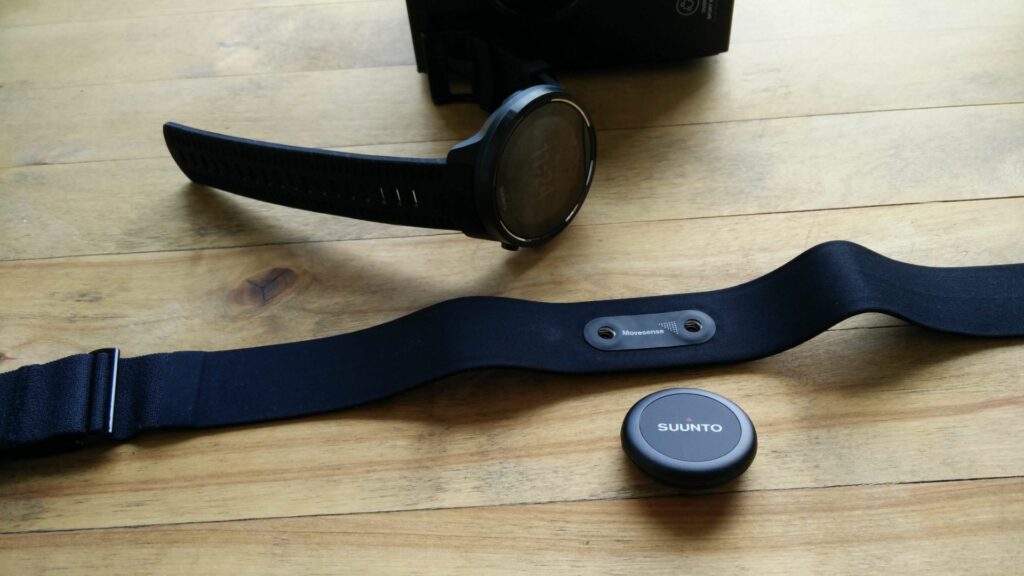
Connectivity: Bluetooth allows you to connect external devices such as chest strap heart rate monitor on the image above
Most hiking watches can be connected to external devices such as heart rate monitors, foot PODs, temperature sensors, smartphones and even action cameras. Three protocols are used for connectivity: ANT+, Bluetooth and Wi-Fi. ANT+ is an outdated protocol which was widely used years ago. New watches typically don’t support ANT+. Nowadays, watches mostly employ Bluetooth for connectivity and some are also equipped with Wi-Fi. The Bluetooth chip is the most important because it enables you to connect the watch to your smartphone. The Smartphone can then work as an intermediate device through which the watch has access to the internet. Wi-Fi enabled watches such as Garmin Fenix 7 can connect directly to the internet without first connecting to your smartphone. That is useful for transferring large amount of data to the watch, such as music.
Battery Life and Battery Modes
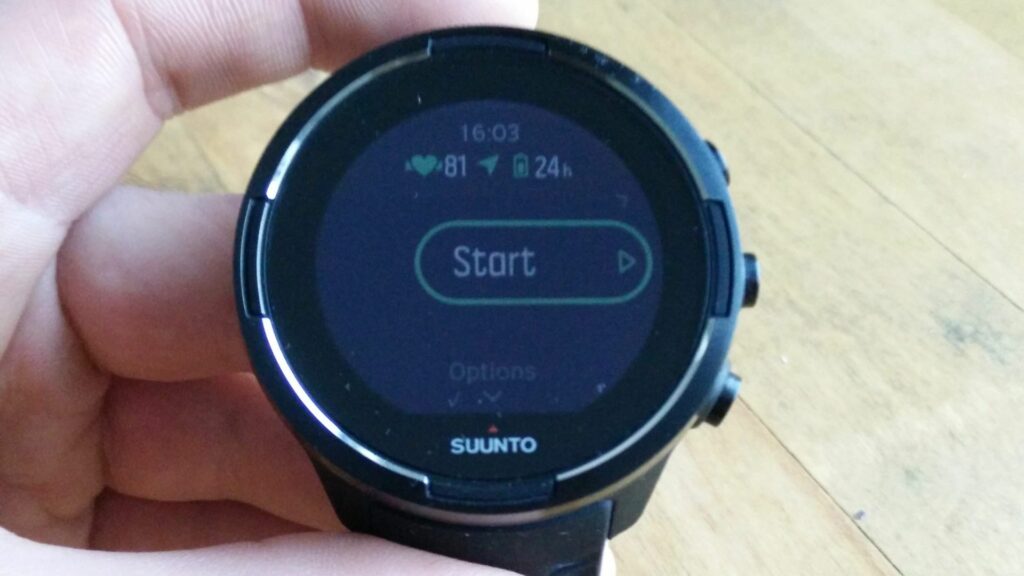
Battery Life: Battery of a GPS watch lasts for a few weeks in time mode but much less in GPS tracking mode
GPS watches are equipped with rechargeable batteries which last for up to two months in time mode. Nevertheless, a hiking watch is rarely used only for checking time and thus the battery life is much shorter in practice. The GPS and wrist HR features put the most strain on the battery. The battery of a hiking watch rarely last more than 30 hours in GPS mode (high accuracy). Nevertheless, most watches allow you to choose different battery modes for GPS tracking. For example, Suunto 9 has four battery modes: Performance, Endurance, Ultra and Tour. The Tour mode delivers up to 170 hours of GPS tracking time which is indeed great.
Watches without GPS use replaceable batteries which typically last for around a year, depending on the use of the watch.
Sunrise and Sunset Times
Sunrise and sunset times are not a must be they are useful because chances are that you’ll forget to check this before heading out. Knowing when the sun goes down enables you to return back before the nightfall and thus keeps you safe.
Interface
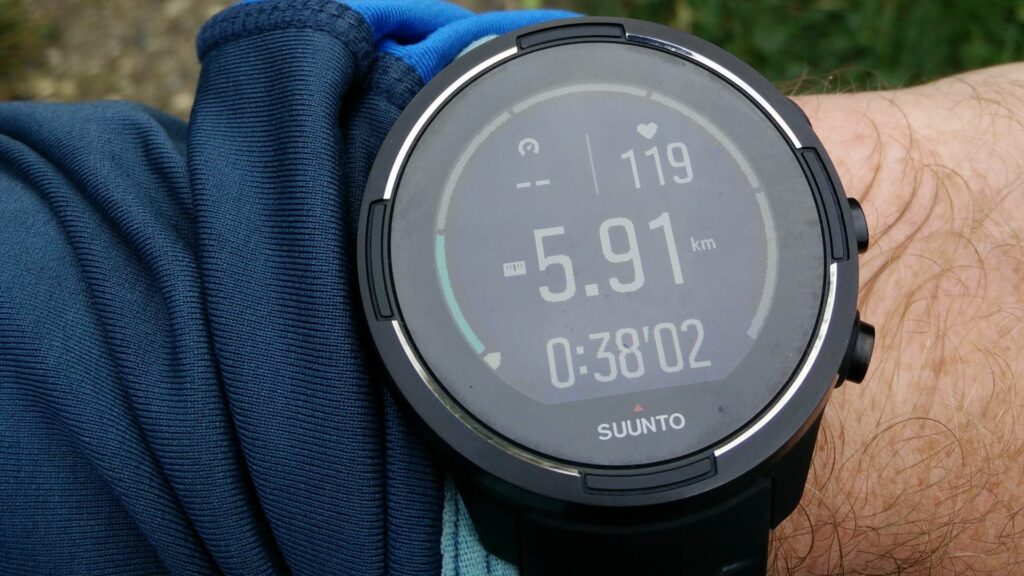
Interface: It’s important that the watch has buttons so you can use with sweaty hands and gloves
Watches are either equipped with a touch screen, buttons or both. Watches that only have a touch screen are not the best option for hiking and sports because they are hard to use with gloves, in rainy weather and with sweaty hands. Therefore, most sports watches are equipped with both buttons and touch screen. During activities the touch screen is usually locked so that the watch doesn’t trigger by the touch of clothes, gloves etc.
